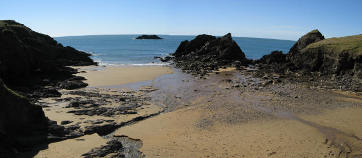2016
THE SALCOMBE LIFEBOAT DISASTER
Once again, Malborough History Group was very pleased to welcome Roger Barrett to speak at its October meeting. Roger’s subject this time was “The Salcombe Lifeboat Disaster”, a timely topic as we approach the centenary of this devastating event.
In the early hours of 27 October 1916, severe southerly gales and heavy seas pounded the South Devon coast causing extensive damage. A number of vessels were driven ashore and others lost at sea. The Western Lass, a 100 ton schooner built in Plymouth, became stranded in a sandy cove near Prawle Point and the lifeboat, the William and Emma, was summoned at 5.50 a.m. Local volunteers from the East Prawle Life Saving Apparatus Company were also called upon and they managed to get the crew ashore by breeches buoy. However, local telephone lines were affected by the storm and the message did not reach the lifeboat in time to stop it being launched, so it was not until they had fought their way out over the Bar and into the Range to within 1½ miles of the stricken ship that they were able to see that they were not needed.
To reach home, the crew now had to sail into the teeth of the gale and, as they tacked back, conditions grew worse, with the wind increasing to near hurricane force. By this time, crowds of people, including the wives and families of the lifeboat’s crew, had assembled on the cliffs to watch the lifeboat combat the surging seas. By now, the men had been in the boat for 3½ hours and the continuous drenching from the waves breaking over her was beginning to sap their strength. The prospect of a long haul round to Dartmouth was not an inviting one and the decision was made to cross the Bar. Just as the crew were about to lower the masts, having lowered the sails in preparation for the very dangerous row in through the huge seas that were breaking across the harbour entrance, a mountainous wave suddenly towered up behind them and pitch-poled the lifeboat stern over bow. The crew, all wrapped in oilskins and wearing lifebelts, were thrown into the boiling surf but lifebelts were of little avail in that terrible sea and, with the exception of Bill Johnson and Eddie Distin, they were soon lost to view. These two lucky survivors were caught by a wave, which hurled them onto rocks near the base of the cliffs and they were eventually rescued.
Roger’s talk was accompanied by a short film narrated by Adam Hart-Davis and featuring Monty Halls and actors speaking the words of Bill Johnson and Eddie Distin. It was a shocking and moving story and is a tribute to those brave men of the William and Emma and all lifeboat crews today who do an extraordinary job risking their lives for the safety of others.
VISIT TO TAVISTOCK
Following Andrew Thompson’s popular talk on the history of Tavistock in February, Malborough History Group joined him there in June for a guided walk to see at first-hand the amazing ruins of the medieval Benedictine abbey and the Georgian and Victorian architecture of this attractive market town. The influence of the Dukes of Bedford in Tavistock’s urban planning and industrial archaeology are so highly valued by heritage professionals that the town is included in the Cornwall and West Devon Mining Landscape UNESCO World Heritage Site.
Andrew is an enthusiastic and knowledgeable guide and really brought the old town to life with historical details and anecdotes. At the end, he proudly gave us an outline of the plans he is currently involved in to develop the old Guildhall/Magistrates Court and Police Station into community areas and an interpretation centre.
BEHIND THE SCENES AT KINGSBRIDGE COOKWORTHY MUSEUM
The History Group had a special treat in April – a ‘Behind the Scenes’ introductory tour of the Kingsbridge Cookworthy Museum. Holly, the knowledgeable and enthusiastic Curatorial Assistant at the museum, had done her homework and dug out some Malborough related items from the collections for us to look at. She found a beautiful Christening cape that had been worn by members of the same local family over several generations, and a 200-year-old Deed to a Malborough property, hand written on parchment, among other interesting items.
Holly also showed us some recent programmes from MAD Group productions, to illustrate how local history isn’t just about ancient artefacts but about the social history of a region up to present times. She explained that the museum’s main objective is to be a community resource and a custodian of items and documents relating to Kingsbridge and the surrounding area. She also described how the museum cares for its archive items using special acid-free sleeves, tissue paper and boxes.
We all had a good look through the photographs on the ‘kiosks’ in the main museum, which house a database of over 16,000 images, and just had time left to have a quick look round the museum exhibits. Most of us had been to the museum at one time or another and seen the wonderful Farm Gallery and the Victorian Kitchen (there was many a cry of “I remember my mother using one of those”!) but they have a turn-over of temporary exhibitions too, which currently include ‘Keep the Home Fires Burning’ about WW1, ‘A Stitch in Time’ and ‘Wish You Were Here’, all based on items from the collections and on loan from local people or museums. Some of us will be making a return journey, either to look at more of the exhibits or to do some research in their Resource Centre, which houses shelf upon shelf of books and documents, along with a Microfilm reader/printer with copies of the Gazette and other local newspapers from 1855, and a set of Parish Records on microfiche.
A lot of local people say: “Do you know, I’ve never visited the museum”! Well, now’s the time. The museum is open from Easter until the end of October. You may even be able to catch a ‘Behind the Scenes’ tour from Holly, if you keep an eye open for one of the special Heritage Days. And if you have a couple of hours a fortnight spare, perhaps you’d like to consider volunteering as a steward.
The June “outdoor meeting” of the History Group is a guided tour of Tavistock by Andrew Thompson, who gave us such an interesting talk about the town in February (see below). The group size is limited and members get first option but there will probably be a few spare places so let Julia Hemming know if you would like to go on the reserve list. It’s on June 2 at 10.30 a.m., for about an hour and a half, and we will make our own way to Tavistock. Cost for non-members is £3.
TAVISTOCK - 1000 YEARS OF HISTORY -- Andrew Thompson
Our February speaker was Andrew Thompson, an archaeologist and historian who has spent his working life exploring, explaining and interpreting the history and heritage of South West England. Andrew has over 25 years experience of teaching, lecturing and leading history and archaeology guided walks and tours and it shows. His virtual tour was centred around the Tavistock Abbey area and Andrew certainly has the ability to bring it all to life for his audience. Andrew does regular guided tours of the town for the general public, too, see his website – www.andrewthompsonheritage.co.uk – for details.
Previous reports

